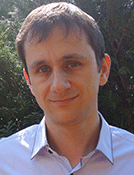2025/11/18(Tue) 14:30 -16:00 一樓演講廳 1F, Auditorium

Title
Quantum effects and Far-from-Equilibrium Transport in Graphene Superlattices
Speaker
Dr. Sergey Slizovskiy (National Graphene Institute, University of Manchester, UK)Abstract
Recent progress in graphene technologies has opened access to the studies of ballistic and coherence phenomena, such as magnetic focusing of electrons, Fabri-Perot resonance [Nano Letters, 18(11), 6725 (2018)], "whispering gallery" modes [Nature Nanotechnology, 18, 250 (2023)] and quantum scars [Nature, 635 (8040), 841–846 (2023)] in graphene quantum dots. In multi-layer graphitic films, coherence also extends vertically, evidenced by quantized standing waves [Nature Physics, 15, 437 (2019)], whereas in graphene heterostructures it enables one to create periodic moiré patterns that qualitatively change electronic properties by forming superlattice minibands for electrons.
When a magnetic field is applied, the interplay with the moiré period creates the "Hofstadter butterfly" energy spectrum, that is manifested by magnetotransport oscillations that survive to high temperatures. We found that, generically, for many moiré systems these oscillations can be traced to Lifshitz transitions in minibands and explained in terms of Aharonov-Bohm interference on open ballistic paths that form a Kagome-shaped network [Nano Letters, 24(2), 601 (2023); Nature, 620, 756 (2023)] (see the above figure).
Electrons in high-quality graphene can be driven to the regime where their drift velocity reaches the Dirac velocity leading to the ballistic current saturation (figure on the right) [Science, 375, 430 (2022)]. In moiré systems, carriers driven by a high electric field can reach the mini-band edges — a process reminiscent of Bloch oscillations — resulting in sharp peaks in differential resistance and, in some cases, in negative differential conductivity (NDC) (see figure on the right). Our theory for these effects accounts for the roles of bandwidth, band overlaps, and inelatic generation of charge carriers (electron-hole pairs). This NDC phenomenon is, now, being harnessed to develop infrared and THz detectors with a single-photon sensitivity [Science, 389, 644 (2025)].
CV
Language
演講語言 (Language): in English